20th Century Fox Animation/Don Bluth Productions (November 21 1997), 20th Century Fox (March 14 2006), 2 discs, 94 mins plus supplements including Bartok The Magnificent feature, 2.35:1 anamorphic widescreen (Bartok 1.33:1 original full frame), Dolby Digital 5.1 Surround, Rated G, Retail: $19.98
Storyboard:
Opening with the fall of the Russian Empire, it’s established early on in Anastasia that this is going to be the Disney-fied fairytale version of the classic real-life mystery. Presenting Rasputin as a master of black magic (and following the unwritten rule that all Disney competitors have to have an evil sorcerer, but at least it’s not Tim Curry’s voice yet again!), we are told that he is responsible for the capture and extinction of Tsar Nicholas II’s family. One child escapes, but is separated from her Grandmother and is left to grow up as an unidentified orphan (voiced by Meg Ryan). She is plucked from obscurity by Dimitri (John Cusack) and Vladmir (Kelsey Grammer), two con artists trying to find a substitute for the missing child, believed to be the Russian Princess, so that they can deliver her to her Grandmother (Angela Lansbury) and claim a reward. Of course, we realize pretty early on that young orphan Anya is in fact the Princess Anastasia, even though it takes the male leads most of the movie to work it out! All the while Rasputin (Christopher Lloyd, in an over-the-top turn reminiscent of his hammy villain in the DuckTales Movie) is out to get Anya before she can return home to her rightful place and thus sealing the curse that zombie-fied him in the first place…
The Sweatbox Review:
Following a deluxe DVD for one of their earlier animated offerings, the eco-friendly adventure FernGully: The Last Rainforest, which gained an extra disc and very nice treatment recently, 20th Century Fox have returned to one of their most ambitious animated films, and the first of only two that were actually created in house by the Fox Animation team (the studio’s other releases had been co-productions, pickups or distribution deals).
Anastasia first hit screens almost a decade ago, in 1997, and came toward the end of the toon boom of the 1990s before computer mice took over from hand drawn ones, and looking back on it again now only emphasises how much traditional hand drawn, musical storytelling is missed. While many jumped on Disney’s single-handed animation renaissance – not least DreamWorks’ Jeffrey Katzenberg, who had been responsible for much of the hoopla surrounding Disney’s return to glory – it was Fox who were first out of the gate in creating product that was anywhere near the quality of the Mouse House’s classic features of old. And, mostly, that was down to one man, Don Bluth, who in years past had left Disney to start his own company with intentions to make the very kind of movies he felt were then lacking at the Studio.
When Bluth left in the late 1970s, he seemed to hit the ground running, artistically speaking, with the fun and fondly remembered Banjo The Woodpile Cat featurette and the brilliant The Secret Of NIMH among his company’s first offerings. A modest box-office success, NIMH was triumphant in its animation, returning to the classic style of the Disney features from the 40s and 50s, and convincing fan Steven Spielberg not only to invest in Bluth’s future, but to eventually launch an entire animated division of his production company Amblin. Together, Bluth and Spielberg created An American Tail, one of the most delightful non-Disney efforts of any time. The film was a giant hit, and Spielberg coaxed George Lucas into co-producing the next animated collaboration, The Land Before Time. Due to Bluth’s insistence that he would be better left to his own devices (he would later remark that there were “too many cooks” on An American Tail), the film was completed at the then-newly built Sullivan-Bluth studio in Ireland. Featuring a score by James Horner and some occasionally wonderfully lush animation, it was with The Land Before Time that the cracks in Bluth’s way of animating started to show and subsequent films have shown that when he’s his own boss the technique may be there but the story is never fully developed.
Spielberg and Bluth parted ways, and while Spielberg’s Amblimation Studio would produce the first of many non-Bluth American Tail sequels among other films, Bluth seemed to simply drift from production to production, seeking finance wherever possible. His deal with Goldcrest Films yielded the messy but popular All Dogs Go To Heaven and the sporadically entertaining Rock-A-Doodle, though he had to jump to Warners in return for them bailing the Bluth Studio out of trouble on Thumbelina and ended up having A Troll In Central Park fumbled by the studio’s lack of marketing and The Pebble And The Penguin forced from his hands. Unsurprisingly, none reached anywhere near the box-office or critical heights of his earlier films, and the Sullivan-Bluth Studio closed its doors. Around this time, Fox chairman Bill Mechanic was making plans, putting together a team at Fox’s brand new, state-of-the-art animation facility in Phoenix. A call went out, inviting Bluth and producing partner Gary Goldman to come on board, with the first project picked for development a re-make of Fox’s own 1956 live-action feature film, Anastasia.
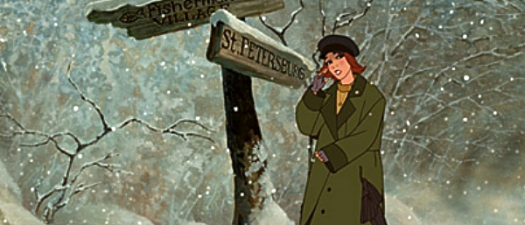
Word was soon out about Fox’s leap into the animation world, and although a few eyebrows were raised at Bluth’s involvement, it was no great surprise. Due to the success of The Lion King, every studio in town was trying to get on the animation bandwagon, with ex-Disney honcho Jeff Katzenberg at DreamWorks the most probable in contesting the Mouse House’s animated crown. Warner was again burned with the badly realized Quest For Camelot (this time created in house), so expectations were high for Fox’s first attempt: could they cut it? Slowly, images began to get released. Industry ads invited audiences to “take a look – you may be surprised!” and promotional tie-ins were as dominant as for any Disney picture. Finally, the film opened to middling-but-strong box-office, although the same year’s big Titanic splash meant audiences dropped off fairly quickly to catch more of Jack and Rose. Now, with all the hype a distant memory, it’s now a good time to look back on the film.
Story-wise, Anastasia is pretty packed, but possibly a little too long at 94 minutes. The second half of the film can seem to take forever, and the final confrontation between Anya and Rasputin could have been a greater battle of wits, especially with more vibrant and exciting animation in place of the fairly uneventful fight on the bridge (what? The Eiffel Tower wasn’t available for a suspenseful high-altitude climax?). As it is, most of the highlights come early, as if the filmmakers were animating this in a linear fashion and became tired towards the end of production. Loose ends are left untied, and there is one character whose decision to switch sides comes late, unexpected and meaningless to the rest of the film. The animation is that strange mixture of full 24 frame movement in the hand-drawing, but with the bizarre choice to have most of the exquisitely rendered CG props and backgrounds play out in 12 frame time, which does not especially help in the fusion of the two techniques.
One thing that used to bug me about the mid-Bluth features was the inability in the main characters to keep their placing registered in the frame. Due perhaps to the cell-method of producing his films, characters would seem to wander and float slightly about, even if they were not specifically moving or walking in shot. Also, there was an odd drop-shadow problem, which occurs when layers are placed upon each other, raising some above others and creating space between the top and bottom background layers. All this used to be apparent in the Bluth films and I was pleased to see these issues disappear with his adoption of CG technology in order to help tell this story. And, quality-wise, it’s almost top level, but is let down by some of the main character animation having a totally rotoscoped look. When live-action footage is used just for the animators’ reference, a very believable movement is achieved in animation. But when the live-action is basically traced frame for frame, it reveals itself with a very stilted and wooden performance. Some of the animation of the more elaborate and secondary characters is more endearing than that of the leads precisely because of this over use of rotoscoping. Bluth maintains that the film was shot first in live-action merely as a reference, but check out those costumes in the added documentary footage – they ain’t painted like that with those thick black lines on ’em for nothing!
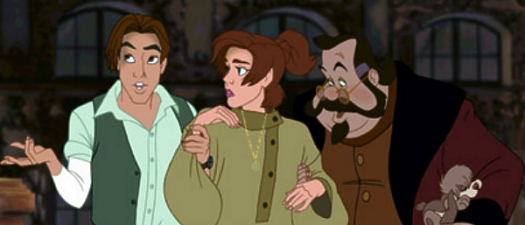
The voice talents do bring their characters to life well, and create real three dimensional personalities. Part of this is in the writing, of course, and praise must be given to Bob Tzudiker and Noni White, among others, for bringing the same adult-skewed mentality to Anastasia as they did to Disney’s The Hunchback Of Notre Dame adaptation. Lynn Ahrens and Stephen Flaherty’s songs are firmly placed in the Disney style of movie musical composition, with the Oscar-nominated Journey To The Past also the clear favorite with score composer David Newman, who uses it for his main theme in his sprightly and majestic music. Rasputin gets a wonderfully deranged villain’s number, although of all the voice talent only Kelsey Grammer and Angela Lansbury perform their own songs, with Aladdin’s Liz Callaway doubling almost transparently for Meg Ryan.
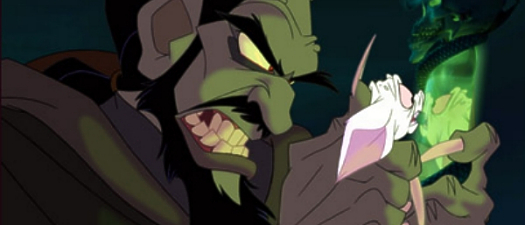
Taking a look back on the film, it still seems to be split between wanting to be a fairytale, while trying to stay purposefully serious in tone. Perhaps the basic story content is a little too tricky a subject to produce in a truly slick, mainstream animated musical form, though its certainly more coherent than previous Bluth outings. Two years later we got a direct-to-video spin-off, Bartok The Magnificent, which did nothing for Bluth’s reputation nor Fox’s continued quest for animation approval. Next up would be the sci-fi adventure Titan AE, slightly muddled in tone due to Bluth’s taking over the project from another director, but still a very enjoyable movie ride and still another enormous step up in script and animation quality, being perhaps Bluth’s most accomplished film since his NIMH and Amblin-associated days.
Despite its open-ended climax and playing hard and fast with the facts, I like Anastasia, even if it does still leave a strangely unsatisfied aftertaste, like the audience has somehow been cheated. Perhaps it’s because we do know how the story really ends, but those still young enough to believe will be thrilled. As for Bluth, well, he hasn’t directed a major piece of animation since Titan, while Fox have gone on to instead back Chris Wedge and Blue Sky Studios, whose CGI animated comedy Ice Age set up a very successful relationship between the two. It’s a terrible shame that Bluth’s two pictures for Fox did not perform as hoped at the box office…he’s undoubtedly a master at what he does, and combined with a new grasping of the CGI techniques, where could Bluth be now? Let’s hope his long-planned Dragon’s Lair movie comes to fruition soon, as we need some good traditional and healthy nourishment in this glutted world of CGI eye candy. When it works, Anastasia is a great reminder of why this overlooked talent is currently missed on screen.
Is This Thing Loaded?
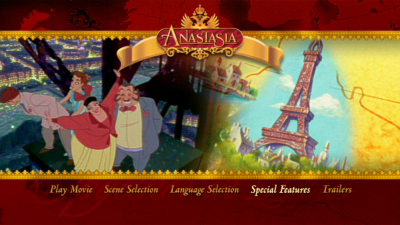
Coming fairly early on in DVD’s young life, the original Anastasia disc nonetheless catered for fans by including a few decent features, including a featurette-length making of documentary, Anastasia: A Magical Journey, and an electronic press kit piece with soundbite interviews from the cast and crew that covered much the same ground. In another review for the film’s first disc incarnation, I asked that a special edition at least include a commentary and the late singer Aaliyah’s music video for the signature song Journey To The Past. Well, they say that when you wish upon a star…
But firstly, and before coming to Anya’s supplementary features proper, we should give good props to Fox for including the complete direct-to-video spin-off Bartok The Magnificent in the set. I’m not sure how well the original disc of this sold, but it couldn’t have made such a dent if they felt a bundle with its more illustrious first film was deemed more worthy of its existence. Although Bartok gets a brief mention on the back of the sleeve, one could never argue this set really came as a double-feature, so I’ve decided on a brief review of the film based on its “bonus” status here. As an animated movie, Bartok combines everything that is good and bad about a Bluth production. The animation isn’t as close to the slightly stilted, but almost Disney-quality of the main feature, but a little more relaxed and loose, not so much relying on the rotoscoping that handicaps Anastasia’s more elaborate scenes. That said, it’s better than what the Mouse House was pumping out at the time from their TV division until Simba’s Pride picked up the pace a bit, but the CGI additions show up like a sore thumb.
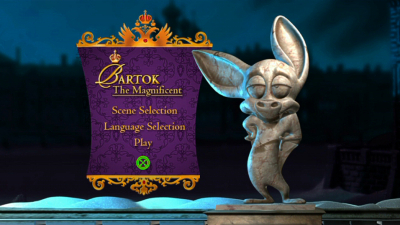
That said, the story once again falls prey to the similar weaknesses found in Bluth’s pre-Fox solo work, with long scenes that could have been trimmed, and did Bartok, Rasputin’s albino bat sidekick really warrant an entire film dedicated to him? Hank Azaria returns to the role, and I believe this was in production before the first film had been released due to Azaria’s performance being tipped as the “breakout character part”. One also wonders, though, why Fox’s A-team of Bluth and Goldman were assigned to what is basically a B-picture – surely a step back down for them after the lofty fully-studio backed widescreen epic nature of Anastasia? Funnily enough, given my comment about serial-animated-villain voice Tim Curry mentioned above, I found it funny that, yes, he plays such a role here!
Perhaps Bluth accepted to make the film to feel back on “safer ground”, and perhaps he had more creative control and was left alone to work the film out as he planned. It does feel very much like a throwback to the independent Bluth films of the 1990s, with all the ups and downs that entails. The story is rather confused, not following the first film chronologically, and working almost as much as a prequel as a sequel, with Bartok the star of a travelling sideshow in a “timeless” Russia that is never concretely painted as being either set before or after the original Anastasia. What there is of the plot has Bartok having to stand up to a crazed royal advisor and her plan to bump off the next heir, Prince Ivan, and prove the heroic tales of his stage performances are not all an act. However, it all soon wanders off into fantasy la-la-land when Bartok meets a Madam Mim clone (and recalling the much better “clean up” scene from the much better The Sword In The Stone) and by the time the villainess starts inexplicably transforming into a dragon creature during a song-and-dance that pales in comparison to Anastasia’s own Rasputin number, all hope feels lost and I just wanted the whole, loud, horrible mess to end.
Frankly, the bat never really did it for me (his allegiance swap toward of the end of Anastasia rendered him a moot character in the long run) and this hour or so feels simply like filler on a wet afternoon. With all the drab songs (surprisingly again by Flaherty And Ahrens, though seemingly happy to mimic the big band sound of Aladdin that every animated knock-off featured for a while), typical character designs, labored performances and an overall lacklustre attempt to ham it all up, Bartok The Magnificent, despite having a fun title, is anything but that and it was a struggle to sit through. For Bluth completists, Azaria fans, and as an extra to the original film only, but I’m glad I caught this on one of its many TV airings rather than coughing up for its initial DVD release and get it as a “freebie” here.

On to Anastasia’s supplements proper, and the aforementioned full-length Audio Commentary with director Don Bluth and producer Gary Goldman. As a fan of their work in general (and a big one of the duo’s discussion on the Titan AE disc), I’m glad to find the pair here are as candid as they were there, really going into the production in depth. Retrospective remarks are always much better than the majority of today’s commentaries, where the filmmakers often record the track weeks before the film hits theaters, and this one was held only towards the end of last year, so there’s lots of going back in time with Don and Gary. Their film history is a little hazy – Don suggests this is one of the first animated CinemaScope films even though Lady And The Tramp pre-dates it by over 40 years – but their history history is spot on, explaining the differences between what really happened and their Hollywood musical take on the mystery. It’s a very enjoyable and intelligent chat, with many amusing exchanges and production anecdotes, and comes as a very recommended listen!
How To Draw With Don Bluth is a five-part look at creating the film’s principal cast: Anastasia, Dimitri, Rasputin and Bartok, with an introduction to Bluth’s style by the man himself. A Play All option runs these all together for a generous half-hour total (with handy gaps for those attempting to draw along), and although I’m not usually a fan of such features and this one is squarely aimed at kids, I was transfixed.

A partial carry over from the original disc is Anastasia’s Music Box Favorites, but instead of just the two Sing-Along versions of Once Upon A December and Learn To Do It presented the first time around as separate sequences, we get the entire 25-minute Fox Sing-Along program that was issued at the time of Anastasia’s release to cash in on the Disney line of the same name. As well as the two aforementioned Anastasia tracks, we also get snippets from Shirley Temple and Danny Kaye’s back catalogs, FernGully, Once Upon A Forest and, quite questionably, the hilarious but out of place Puttin’ On The Ritz from Gene Wilder and Mel Brooks’ Young Frankenstein.
And as if all of that wasn’t enough (or was too much, depending on your point of view), we also get the Anastasia segments of those Sing-Alongs presented as separate clips. Oddly, and while one would think that they would recycle the material from the main Sing-Along program, these versions of Once Upon A December and Learn To Do It are presented as individual clips, using the cropped full-screen video from the Sing-Along program, but windowboxing the sequences within an anamorphic frame…!
Completing Disc One is a very welcome series of Theatrical Trailers, including an early industry teaser for Anastasia, the original full trailer from the first disc pressing, and an international TV spot. Although, as usual, these previews don’t hold up to feature transfer quality, they are all surprisingly presented in anamorphic widescreen, something this disc strives to do whenever possible, which is a nice touch. Previews for the live-action comedy Little Manhattan and the remake of Cheaper By The Dozen are also to be found, along with a generic preview for Fox’s new animated editions of Ice Age, FernGully and, of course, Anastasia. While I suspect that Titan AE will remain as issued in its already pretty stacked disc, I wonder if Fox are considering applying the same Family Fun treatment to The PageMaster and Once Upon A Forest, the two remaining films in their traditionally animated library?
On to Disc Two and we’re quickly treated to some elaborate DVD menus that re-create the Romanoff Palace in CGI. However, it’s soon apparent that searching for all the bonus features “hidden” in the palace is going to take a few days – thankfully Fox have bothered to include a “map scroll” that lists the extras in a much more linear and easy to access approach. There’s no denying the great work put into the palace exploration menus (there are numerous “clickables” that fill the viewer in on the life and times of the real Anastasia), but for ease-of-review’s sake, I went with the straight list.
After the aforementioned Bartok feature, which gets its own menu and scene selection identical, I suspect, to its original issue, we move on to The Making Of Anastasia, a six-part documentary that replaces its Musical Journey counterpart from the earlier disc and runs a healthy 44-minutes here when selected with the Play All option. Covering all aspects from the Story, Research, the Look, Designing Characters, the Voices and Music, it’s clear from Don and Gary’s comments that their segments were recorded recently, while the other cast and crew are represented in archive behind-the-scenes clips.
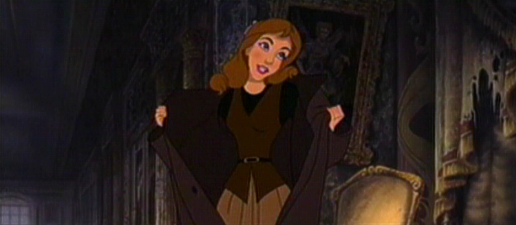
What this immediately says is that Fox has taken a little care and thrown a bit of money towards this set, minting a new documentary instead of just re-hashing previously issued material, and it’s all the more appreciated, even down to the animated captions that name the speakers. One highlight is the original animated clip that captured Meg Ryan’s participation in the film, and a much softer and more visually appealing version of the title character she is too in this test. As good as any of the retrospective documentaries on the Disney Platinum Editions, this digs deep to feature liberal amounts of footage from all stages of production and is also presented in anamorphic widescreen, no less!
Learn To Sing In A Foreign Language adds a bit of meat to the sometimes included international song sequences where a popular track from the movie is played out while skipping between various localised versions. Here, the viewer is invited to learn the songs, Journey To The Past and Once Upon A December using the International Phonetic Alphabet. An introduction sets up the IPA and how to pronounce the sounds, while two “learning tracks” break the songs down in order to perfect your renditions. Finally, and if all that is too much work, you can view the standard multi-language version sequences of Journey and December in full uninterrupted mode as individual selections. Great fun, as these can be, and wonderful to hear how close on vocal model the various international dubs were able to keep to Liz Callaway’s original takes.
Next up are three interactive set-top games: Anya’s Day Out is a “dress Anastasia correctly for the location” type diversion, which is fun if you want to place her in the snow in a ball gown and a silly hat, while Rasputin’s Revenge isn’t another sequel spin-off but a rather fun game in which the player, as Bartok, has to stop the mad monk from literally going to pieces by catching dropping off body parts. Finally, Help Anya Remember is a trivia game in which the player must answer questions based on the movie and the real Anastasia. A right answer fills in a missing piece of the puzzle, while a wrong one gets a stern telling off from Sophie and a declination to access the Grand Duchess. Although the Rasputin game was a little confusing as to whether I was doing well or losing and became fairly repetitive very fast, at least Fox have provided anamorphic games that have had a little thought put into them and cleverly use animation from the movie, though it’s a shame the puzzle games from the original release were not brought over too.
Now, remember way back at the top of this extras section where I said my second wish on an Anastasia special edition would be the movie’s original soundtrack tie-in song? Well that wish is certainly granted with the inclusion of Aaliyah’s Journey To The Past music video, which got heavy play rotation during the film’s theatrical release. I love animated film videos which really connect to the film they’re promoting (as opposed to the usual studio recording booth shots and clips from the completed movie simply cut against each other) and this one is one of the best, featuring some clever combining of a live-action Aaliyah performing and interacting with character animation and background locations from the film – pure magic!
Even better is that this complete four minute music video is accompanied by its own three-and-a-half minute Making Of Aaliyah’s Journey To The Past bonus clip, which centers more on the singer in the studio and her interpretation of the track rather than on the way she was inserted into Anastasia’s animated world, but is no less welcome. Both the music video and its behind-the-scenes featurette are presented in anamorphic widescreen, with the video fittingly dedicated to its performer, who tragically died in an accident in 2001, and the studio footage an affectionate tribute that needs no such dedication in order to make a non-fussy but poignant point.
Dropped from the film’s first DVD incarnation, for the record, are The Magical Journey Of Anastasia TV special hosted by Aaliyah and an EPK documentary featurette that ran 22:30 and seven minutes respectively. It’s a shame that these have gone AWOL since they gave a good condensed history of production, especially the Aaliyah special, so fans may want to consider keeping their earlier discs for those reasons. A couple of interactive puzzle games and a trailer for Bartok are less lamentable in their absence. However the new documentary packs a punch, and we do get the entire Bartok The Magnificent, for what that’s worth, as an extra. With the included commentary, we finally get all the things we should have gotten first time around, especially the Journey To The Past music video which has always been one of my favorites.
Case Study:
Sticking with the Family Fun style of FernGully (and a lot of the recent Fox re-releases), Anastasia comes in a blue slimline 2-disc case housed (in initial pressings at least) in an embossed slipcase. Enclosed is a “movie-money” ticket to Fox’s Ice Age 2: The Meltdown in theaters, while a coupon book offers some deals on other titles. A one-page insert lists the chapters (same indexes as the first issue) and the bonus features. There have been many complaints about the artwork used on the front cover, but watching the film again, one must point out that Anya doesn’t always stay on model all the time and sometimes comes very close to representing the girl featured on the front of the sleeve here. For some reason, the lighter print tone of the case sleeve itself (as opposed to the slipcover) somewhat limits the “damage” further, and it doesn’t appear to be as severe a rendering even though it’s the same image. However, there’s no denying that the original cover was much preferable, so I’m keeping my earlier copy for that and for the sadly missing original documentary that is MIA here.
Ink And Paint:
As with FernGully’s recent surprise showing on its reissued DVD, Anastasia has been given an anamorphic overhaul. The film retains its deep and rich look from the original pressing, which was none too shabby itself. Bluth is not afraid to have everything sparkle and shine, with bright yellows, deep blues and vibrant reds holding their own against everything else on screen. The disc presents the original – and preferred – 2.35:1 aspect ratio, and thanks to dropping the original disc’s alternative and pointless pan-and-scan version, this transfer is infinitely superior.
While still sourced from a film print as opposed to a digital copy, the gate weave seems to be less apparent and the element is sharp and clean, with no particular grain and noticeably less digital noise going on in the image. Anastasia was, at the time, one of the few non-Disney CinemaScope-styled features and Bluth uses his wider frame to the max. If anything, this is better than the original, faultless transfer. The film’s bundled-in direct-to-video sequel, Bartok The Magnificent, also looks good in its original production negative ratio of 1.33:1 full frame, with an image that is more than satisfactory and as sharp as it should be from a rock-solid direct digital transfer.
Scratch Tracks:
Seemingly armed with the same Dolby 5.1 Surround English track as before, the Anastasia mix remains very active – they really were trying hard with this one! Though now pushing ten years old, you’ll still find all your speakers going at it for almost the entire feature, with music, voices and effects all vying for attention. Separation can really be felt and the bass shakes the floor, with the surrounds expectedly less dynamic, but offering a spaciousness that opens out the audio. The included French and Spanish dubs (with English and Spanish subtitles also on hand) are as good as would be expected for a big studio movie, especially one that would be used to creating foreign language versions for international distribution. From the previous disc, this edition loses the standard Pro-Logic surround, instead gaining the commentary with the film’s two major players. Bartok gets the same dub and subtitle treatment.
Final Cut:
I’m not sure that I’ve seen any major studio DVD offering of a classically animated motion picture reach the heights of a Disney Platinum Edition, but with this Family Fun set, Fox certainly have pulled one out of the bag. A superior commentary, more than decent documentary, tons of promotional material including the trailers and music video, usual suspects such as sing-alongs and multi-language versions plus an entire second feature means a solid double-disc experience topped off with a low-list price that’s a steal and a terrific transfer of the original feature film.
Although the second half of the film, after the Learn To Do It musical sequence, begins to drag, and the climactic Paris-set battle on the bridge is nowhere near as big as it should be, Anastasia works well enough for the audience it has its eye on. Perhaps a little could have been shaved from its 94 minute running time, but it does pack a lot in and the story is given a definitive ending that doesn’t shy away from answering the eternal mystery over who exactly the young girl was, even if it’s not the right answer!
While not quite up to the standard or self-assured as late 90s Disney, Fox and Bluth put in a valiant attempt and it’s absolutely the best thing Bluth has done in this genre since NIMH and An American Tail, though Titan AE is, for my money, the most visually elaborate Bluth picture. Anastasia’s only major fault is that it tries too hard to be the fairytale it can never truly give itself over to be. There are some fine moments, mainly in the first half, and overall it was a return to form for Bluth. This disc comes just at the right time to remind those who need reminding that he got it right here, and deserves to be let loose on another feature – and soon!
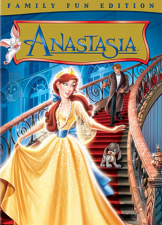 | ||
 |







